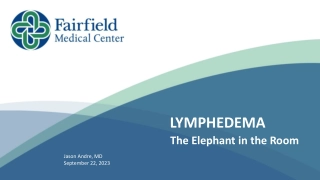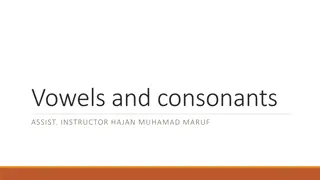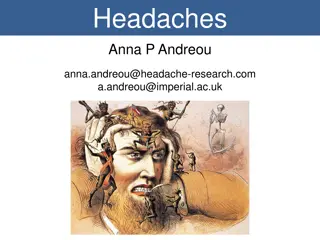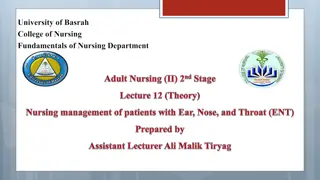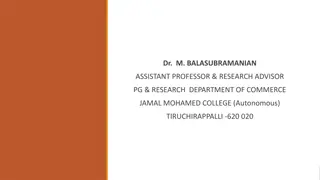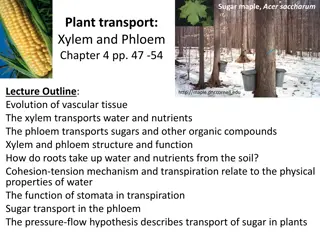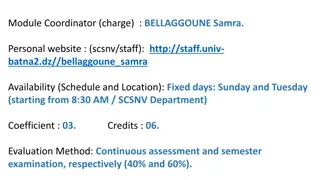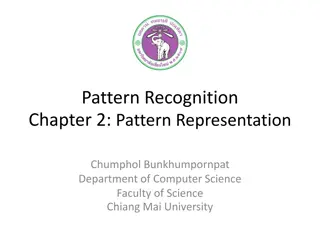Understanding Classification of Malocclusion in Orthodontics
Occlusion refers to the alignment of teeth when the jaws are closed. Ideal occlusion is rarely found in nature, while normal occlusion entails a smooth alignment of teeth. Malocclusion, on the other hand, reflects variations in how upper and lower teeth come together. This classification of malocclusion covers different types, including intra-arch, inter-arch, and skeletal malocclusions, each with various subcategories affecting different planes of the jaw. Understanding these classifications is essential in orthodontics for diagnosis and treatment planning.
Download Presentation
Please find below an Image/Link to download the presentation.
The content on the website is provided AS IS for your information and personal use only. It may not be sold, licensed, or shared on other websites without obtaining consent from the author. Download presentation by click this link. If you encounter any issues during the download, it is possible that the publisher has removed the file from their server.
Presentation Transcript
CLASSIFICATION OF MALOCCLUSION DEPARTMENT OF ORTHODONTICS AND DENTOFACIAL ORTHOPEDICS
OCCLUSION Occlusion is defined as the relationship of the maxillary and mandibular teeth when the jaws are closed in centric relation without strain of the musculature or displacement of condyle in their fossae 3
Occlusion Ideal occlusion: based on the anatomy of the teeth and rarely found in nature An ideal occlusion is a hypothetical or theoretical concept 4
Occlusion Normal occlusion: were in a relationship whereby the mesiobuccal cusp of the upper molar occluded in the buccal grove of the lower molar and the teeth were arranged in a smoothly curving line of occlusion The normal occlusion was when the upper and lower molars 5 Contemporary orthodontics,by William Proffit, 5th edition
Occlusion Malocclusion: Malocclusion is a condition that reflects an expression of normal biologic variability in the way the maxilla & mandible teeth occlude 6 Contemporary orthodontics,by William Proffit, 5th edition
CLASSIFICATION OF MALOCCLUSION 7
TYPES OF MALOCCLUSION Intra- arch Inter- arch Skeletal 8
INTRA-ARCH MALOCCLUSIONS Tipping mesial, distal, labial, lingual Displacements - mesial, distal, labial, lingual Infraversions and supraversions Rotations Transposition 9
INTER-ARCH MALOCCLUSIONS Sagittal plane Vertical plane Transverse plane Pre-normal occlusion Post-normal occlusion Deep bite Open bite Crossbites 10
SKELETAL MALOCCLUSIONS Sagittal plane Prognathism Retrognathism Transverse plane Narrowing or widening of jaws Crossbites Vertical plane Open bite and deep bite Affects Lower facial height 11
Methods of recording & measuring malocclusion is broadly divided into two types by Tang & Wei in 1993 Qualitative methods Quantitative methods Angle s classification - Little's Irregularity Index Mod: Dewey s modification - Treatment Priority Index Lischer s modification - IOTN Simon s classification Bennett s classification Ackermann- Profit classification British standard classification for incisors GRABER,orthodontics principle and practice 12
ANGLES CLASSIFICATION By EDWARD HARTLEY ANGLE Was considered the father of modern dentistry Based on the anterior posterior June 1, 1855 August 11, 1930 relationship of the jaws Maxillary 1st molar was the key to normal occlusion 13 GRABER, orthodontics principle and practice
Angles classification 14 GRABER, Orthodontics principle and practice
Angles classification CLASS I CLASS II DIVISION I DIVISION II TYPE A TYPE B TYPE C CLASS II SUB DIV CLASS III TRUE PSUEDO CLASS III SUB DIV 15 GRABER,orthodontics principle and practice
Angles classification CLASS I MALOCCLUSION The mesiobuccal cusp of maxillary permanent first molar occludes in the buccal groove of the mandibular permanent first molar 16 Textbook of orthodontics, by Samir Bishara
Angles classification CLASS II MALOCCLUSION The mesiobuccal cusp of maxillary permanent first molar occludes in the space between mesiobuccal cusp of mandibular permanent first molar and distal aspect of buccal cusp of second premolar. 17 Textbook of orthodontics, by Samir Bishara
Angles classification CLASS II DIVISION 1 A Class II malocclusion in which the maxillary incisor teeth are in labioversion. 18 Textbook of orthodontics, by Samir Bishara
Angles classification CLASS II DIVISION 2 A Class II malocclusion in which the maxillary incisor teeth are not in labioversion. 19 Textbook of orthodontics, by Samir Bishara
Class II division 2 is classified as : a) The maxillary central incisors are tipped palatally and the laterals are in labioversion or normally inclined b) The four maxillary permanent incisors are tipped palatally, with the canines are in mesiolabial version c) Linguoversion of all six anterior teeth d) Mixed type of frontal malposition with lingually inclined incisors on one side 20
Angles classification CLASS II SUBDIVISION When there is class II molar relation on one side and class I molar relation on the other side it is known as class II subdivision 21 Textbook of orthodontics, by Samir Bishara
Angles classification CLASS III MALOCCLUSION The mesiobuccal cusp of the maxillary permanent 1st molar occludes in the interdental space between the mandibular 1st and the 2nd molars. 22 Textbook of orthodontics, by Samir Bishara
DEWEYS MODIFICATION (1935) Given by Martin Dewey, initially Angle s prot g but later his rival. He gave modification for Angle s class I and III classifications 23
Angless classification.. Modification of Class I Class I molar relation with : Type 1: crowding of anterior teeth. Type 2: proclined upper incisors. Type 2: proclination of anterior teeth. 24
Angless classification.. Type 3: anterior cross bite Type 4: posterior cross bite 25
Angles classification.. Type 5: mesial migration of molars due to early loss of teeth mesial to them 26
Angless classification.. Modification of Class III Class III molar relation with : Type 1 :edge to edge incisor relationship. 27
Angless classification.. Type 2 :mandibular incisor crowding and lingual relation to maxillary incisors Type 3 :maxillary incisors are crowded and in cross-bite 28
Angles classification.. LISCHER S MODIFICATTION Used different terminologies for the same molar relationships described by Angle. Nuetro occlusion: synonymous to Angle s class I malocclusion. Disto - occlusion : synonymous to Angle s class II malocclusion. Mesio - occlusion : synonymous to Angle s class III malocclusion. 29 Handbook of orthodontics, 4th edition, Robert E. Moyers
Angles classification.. He described individual tooth malpositions : position version. Lingoversion/ labioversion Mesioversion/distoversion Infraversion/supraversion Torsiversion or rotation Perversion or impaction Transversion or transposition 30 Handbook of orthodontics, 4th edition, Robert E. Moyers
SIMONS CLASSIFICATION Simon classified malocclusion in three planes: 1. Frankfort horizontal plane 2. Orbital plane 3. Mid-Sagittal plane 31 Handbook of orthodontics, 4th edition, Robert E. Moyers
1. Frankfort horizontal plane: external auditory meatus to infra-orbital margins this plane connects the upper margin of Used to classify malocclusion in vertical plane 2. Orbital plane : pass through the distal third of the upper canine (Simons law of canine) perpendicular to FHP, this plane should Describes malocclusion in sagittal plane 3. Mid-sagittal plane: direction used to describe malocclusion n transverse 32 Handbook of orthodontics, 4th edition, Robert E. Moyers
ATTRACTION FRANKFORT HORIZONTAL PLANE ABTRACTION PROTRACTION ORBITAL PLANE RETRACTION CONTRACTION MID SAGITAL PLANE 33 DISTRACTION
BENNETS CASSIFICATION Norman Bennett classified malocclusion based on its etiology: Class I - Abnormal position of one or more teeth due to local causes. Class II - Abnormal formation of a part or whole of either arch due to developmental defects of bone Class III- Abnormal relationship between upper and lower arches, between either arch & facial contour or correlated abnormal formation of either arch 34 Handbook of orthodontics, 4th edition, Robert E. Moyers
ACKERMAN-PROFIT CLASSIFICATION Ackerman and Proffit proposed a diagrammatic classification scheme of malocclusion It is based on Venn symbolic diagram that identifies five characteristics and their interrelationships 35 GRABER,orthodontics principle and practice
Ackerman-profit classification CLASS TYPE Sagittal Deviation (A-P) Cl I Ant displacement Cl II div 1 div 2 Cl III -dental -skeletal Transverse Deviation (Lateral) Buccal Palatal Unilateral - Bilateral - dental - skeletal Trans Sagittal Trans- Sagitto- Vertical Vertico- Transverse Sagitto- Vertical Ant Divergent Post Divergent Straight Concave Convex Profile Vertical Deviation Open bite-Anterior -Posterior Deepbite Collapsed bite -dental -skeletal BITE DEPTH Ideal Crowding Spacing Intra-arch Alignment / symmetry 36
BRITISH INCISOR CLASSIFICATION Class I Class II Division 1 Division 2 Class III 37 GRABER,orthodontics principle and practice
KATZ PREMOLAR CLASSIFICATION(1992) Class I: The most anterior upper premolar fits exactly into the embrasure created by the distal contact of the most anterior lower premolar. 38 Orthodontics,diagnosis and management of malocclusion and dentofacial deformities, Kharbanda
Class II : The most anterior upper premolar is occluding mesial of the embrasure created by distal contact of the most anterior lower premolar Class III: The most anterior upper premolar is occluding distal of the embrasure created by the distal contact of the most anterior lower premolar 39 Orthodontics,diagnosis and management of malocclusion and dentofacial deformities, Kharbanda









